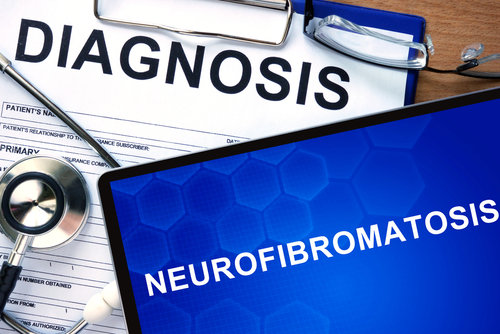Neurofibromatosis– a primer
M3 India Newsdesk Apr 19, 2018
Here is a primer on Neurofibromatosis, a rare multisystem disorder characterized by a neuroectodermal abnormality, causing tumors to form on the nerve tissue.

Neurofibromatosis, also known as Von Recklinghausen's disease, is a genetic disorder characterized by a neuroectodermal abnormality. The clinical manifestations of systemic and progressive involvement can affect the skin, nervous system, bones, eyes and possibly other organs. The disease manifestation may vary from individual to individual.
Gawlewicz-Mroczka et al. reported the case of a 32-year-old woman who was suspected with a lung tumour, but later diagnostic testing, such as chest CT and PET along with ophthalmological examination, led to the diagnosis of neurofibromatosis type 1.
Singh SK, Mankotia DS, Borkar SA and Gupta UD (Neurol India 2017;65:428-9) reported the case of a 15 year adolescent with NF-1 having multiple subcutaneous swellings (neurofibromas) all over the body of various sizes, involving the neck, chest, abdomen, and trunk. The patient presented to the outpatient department with a tingling sensation over the right upper limb middle finger gradually increasing in intensity since the past 15 days.
Korf BR (Handb Clin Neurol. 2013;111:333-40.) describes "neurofibromatoses" as a set of distinct genetic disorders that have in common the occurrence of tumors of the nerve sheath. He explains that they include NF1, NF2, and schwannomatosis and highlights the fact that all are dominantly inherited with a high rate of new mutation and variable expression.
He further states that NF1 includes effects on multiple systems of the body and the major NF1-associated tumor is the neurofibroma. In addition, clinical manifestations may include bone dysplasia, learning disabilities, and an increased risk of malignancy.
Korf BR explains that NF2 includes schwannomas of multiple cranial and spinal nerves, especially the vestibular nerve, as well as other tumors such as meningiomas and ependymomas. The schwannomatosis phenotype, he says, is limited to multiple schwannomas, and usually presents with pain.
The genes that underlie each of the disorders are known: NF1 for neurofibromatosis type 1, NF2 for neurofibromatosis type 2, and INI1/SMARCB1 for schwannomatosis.
What statistics say?
- NF1 is diagnosed in approximately 1 in 3500 people; the estimated incidence of NF2 is 1 in 40,000 people.
- In nearly 50% of the cases, the condition is inherited (autosomal dominant inheritance pattern), the other half cases are a result of sporadic mutations.
- In 3-5% of the cases, the benign tumours may become malignant.
Neurofibromatosis (NF) – An overview
Neurofibromatosis (NF) is an uncommon genetic disorder that causes benign tumours in the nervous system. Among the two well-known types of NF, neurofibromatosis type 1 (NF1) is more common in occurrence than neurofibromatosis type 2 (NF2); a third type known as ‘Schwannomatosis’ has been recently identified.
In NF1, the tumours are neurofibromas, while in NF2 and schwannomatosis, tumours of Schwann cells are more common. Genetic mutations in NF1 gene (chromosome 17) and NF2 gene (chromosome 22) cause the respective neurofibromatosis types; these mutations can be inherited.
To diagnose NF1, one must have at least two of the following criteria:
- Six or more café au lait spots (0.5 cm or larger in children, 1.5cm or larger in adults)
- Two or more cutaneous/subcutaneous neurofibromas or one or more plexiform neurofibroma
- Freckling in the armpit or groin
- Optic glioma
- Two or more Lisch nodules
- A bony dysplasia
- A first-degree relative with NF1
Diagnostic criteria for NF2 are (minimum two criteria must be met):
- Bilateral vestibular schwannomas
- Family history of NF2
- Glioma
- Meningioma
- Presence of neurofibromas
- Juvenile cataracts
How to diagnose NF
NF can be diagnosed by Physical examination, Family history, medical history, X-rays, CT scan, MRI scan, biopsy of neurofibromas, eye tests, genetic testing (for individuals at 50% risk).
Differential Diagnosis of NF1
The conditions with café au lait patches or pigment changes combined with café au lait patches require differential diagnosis for better treatment planning.
Tumours can be misdiagnosed as neurofibromas, to avoid misinterpretation differential diagnosis must be performed, these include other forms of NF, like– mosaic NF1, Watson syndrome, NF2, autosomal dominant multiple café au lait spots.
Other conditions with café au lait spots may include – DNA repair syndromes, McCune-Albright syndrome, homozygosity for one of the genes causing hereditary non-polyposis cancer of the colon.
Tumours are confused with neurofibromas in the cases, such as Banayan-Riley-Ruvalcaba syndrome, lipomatosis, Fibromatoses, multiple endocrine neoplasia type 2B.
Once the diagnosis confirms NF, there are good and precise treatment measures available, such as surgical removal or radiation therapy. It is highly recommended to conduct a differential diagnosis if the medical condition is uncertain.
-
Exclusive Write-ups & Webinars by KOLs
-
Daily Quiz by specialty
-
Paid Market Research Surveys
-
Case discussions, News & Journals' summaries